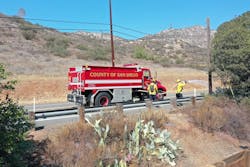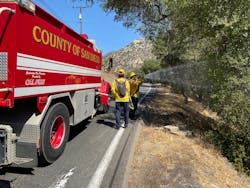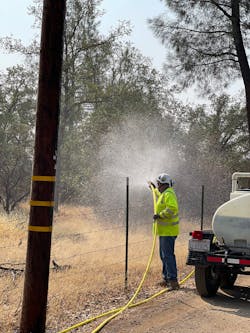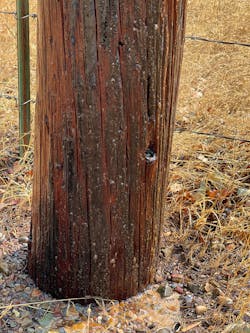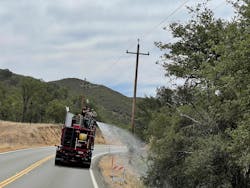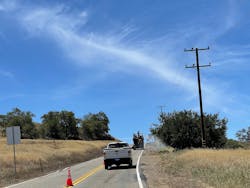To address wildfire challenges, most utilities are hardening T&D lines and infrastructure, moving their lines underground, performing enhanced vegetation management and, in the worst cases, shutting off power to customers through public safety power shutoff (PSPS) events or changing settings to trip the power off even with small disturbances. However, some utilities are turning to a long-proven and effective solution: long-term fire retardants (LTRs). They are applying retardant to vegetation surrounding utility poles, substations and critical infrastructure at the beginning of wildfire season as well as directly applying it to the utility poles themselves in the event of an approaching wildfire.
Although retardants have been in use for decades, with recent advancements in the technology, utilities around the globe are now looking to this solution as a new tool. Retardants can be preventively and rapidly deployed to reduce catastrophic liability from T&D infrastructure causing ignitions, while at the same time protecting that same infrastructure from incoming wildfires. The use of LTR is expected to expand rapidly over the next two years to four years as utilities work to implement capital improvements that will cost billions of dollars and take much longer than a decade to complete.
LTR History
LTRs have been safely and effectively used in the U.S. since the 1960s. The technology works by coating vegetation with a small amount of ammonia and phosphates that helps to render the vegetation and cellulosic material nonflammable until the active ingredients are removed by rainfall. Traditionally, the product is red in color, so that — when facing an oncoming wildfire — utilities and pilots who are applying more LTR can see where they have already applied retardants, to create continuous retardant lines with no breaks. The red color provides no additional effectiveness and does not change the environmental friendliness of retardants.
Many different fire-retardant chemicals have been tested by the U.S. Forest Service over the last 60 years for efficacy and environmental qualifications. Retardants with different ingredients have been explored for decades, including magnesium chloride and even boric acid. Independent studies have proven they were much less effective and worse for the environment than phosphate-based retardants. For these reasons, the Forest Service and fire agencies continue to use phosphate-based retardants to protect wildland vegetation from fire.
Safety And Protection
Utilities adopted the application of LTRs around a decade ago and started applying the product directly to utility poles as well as around their assets in the face of approaching wildfires. Safety and infrastructure protection teams (SIPTs) have proven to be highly effective in saving poles as well as millions of dollars that otherwise would have been spent in replacing the destroyed infrastructure. One utility privately reported it applied LTR to 16,000 poles ahead of an approaching wildfire, and 3000 of them were impacted directly by wildfire. Of those poles impacted, 2820 of them, or 94%, did not have to be replaced. This resulted in US$63 million in savings in one year alone.
Utility-led SIPTs also have supported county, state and even federal firefighting agencies at times in some of the most devastating wildfires. They store hundreds of pallets of red, and sometimes uncolored, PHOS-CHEK liquid concentrate ahead of wildfire season. When a fire is approaching, an SIPT can mix roughly 5 gal (23 L) of water to every gallon of the stored concentrate and quickly apply the LTR themselves to the utility infrastructure.
The product is applied up a pole approximately three times the fuel height, generally 10 ft to 15 ft (3 m to 5 m) up a utility pole. It should not be applied to the insulators or conductors, as the retardant could potentially affect conductivity, create an arc flash or relay, or cause an injury to the applicator (touch potential through hose stream) if sprayed onto the top of the pole on energized conductor (wire), given the water and salt content. Standard agricultural, tank and pump units, fire apparatus and garden spray equipment with liquid pumps and spray nozzles are used to cover the pole and surrounding vegetation until it is wet with retardant. After the water evaporates and the LTR dries, the product still provides retardant effectiveness until it is either washed off or removed by rainfall.
Continued Advancement
Universities and companies have continued to innovate on fire chemical solutions that can be used not only in a reactive manner after fires begin but also in a preventive and proactive manner at the start of wildfire season. Professors at Stanford University published research in 2019 in the Proceedings of the National Academy of Sciences (PNAS) that a breakthrough polymer had been created to mix with the most effective phosphate-based LTRs in the industry. This uncolored product had significantly enhanced adherence and durability properties compared to traditional LTR, which allowed the retardant to be applied at the start of fire season and last potentially all the way through peak fire season with only a single application.
Although the breakthrough polymer had been in development for years, the necessity to bring a preventive LTR solution to the utility and transportation industry — where, in some geographies, 80% of fires were started — accelerated the new tool in becoming commercially available. In October 2021, the Forest Service added the first high-adherence and highly durable phosphate-based LTR to its qualified products list (QPL), granting its approval for it to be applied preventively in wildlands.
Utility Use
Utilities began using the uncolored, durable LTR along roadsides and around utility poles as early as 2019. They started applying the LTR specifically to utility infrastructure located along county roads and on private land, while they waited for official approval to come from the Forest Service. Given the urgent need for new solutions, California utilities were some of the first to deploy the technology. Other utilities started following their lead by using the new LTR ahead of prescribed burns and in collaboration with organizations, such as Pheasants International. This enabled them to maintain plant habitat during prescribed burns under their high-voltage power lines, so birds could have ground cover.
The environmental community also started to embrace the new, durable LTR solution as one of the best available options for utilities to deploy in the community. Some utilities and communities were starting to face liability after applying herbicides that killed vegetation and removed vegetation to reduce ignitions. In other situations, utilities were clearing vegetation down to bare mineral soil, which caused environmental issues with erosion, mudslides and soil health issues in some parts of the country. In Southern California, people even started getting sick with valley fever when the California Department of Transportation started to scrape roadsides to bare mineral soil, to help eliminate ignitions from automobiles.
The application of phosphate-based LTRs on what many in the fire community call “light-flashy vegetation” (one-hour fuels), which signifies that even small sparks can cause ignition, then started to play a dual role the environmental community supported. Using LTR, San Diego County and plant studies performed by Pepperdine University found vegetation habitats could be maintained in place while retardants helped to render it nonflammable throughout the fire season.
After the winter rains came, phosphate-based retardants helped the plants recover from the drought season by increasing microbial life, soil health and root health. In turn, this helped to prevent the erosion, silt and mudslides that occur when clearing vegetation, and kept the habitat in place for the environment, allowing native plant species to outcompete fast-growing invasive species that arrive after a wildfire moves through an area.
Community Partnerships
Many public utilities see themselves as a critical part of not only providing power to their customers but also protecting them from traditional causes of wildfire ignitions unrelated to utility infrastructure. Inside many utility wildfire mitigation plans (WMPs) today, dollars are being set aside for community wildfire safety.
This was proven highly valuable by one California utility that placed the uncolored, durable LTR along a high-risk roadside where its infrastructure ran parallel to the road. The utility applied some retardant under its power lines and around utility poles as well, which introduced two benefits simultaneously:
- It prevented any possible ignitions from occurring under or near the lines, even if the ignition came from discarded smoking material, a car hitting the utility pole or hot metal coming off an overheated vehicle.
- It enhanced public/residence evacuations as well as fire personnel and utility vehicle ingress and egress on roads with only one way in and one way out, enabling utility customers to safely evacuate and essential personnel to get into the area in the event of an approaching fire.
This proved true for the utility in late 2021 when a fire ignited on a road in San Diego County, California. A car caught on fire in Wildcat Canyon, across the road from where retardant had been applied previously under power lines, and the retardant helped to keep the fire from spreading.
More state transportation agencies, fire agencies, and even communities are looking to partner with utilities for the preventive and proactive application of LTR going forward. Utilities will play an important role in not only taking care of their own vegetation management activities but also providing vegetation management up to 50 ft (15 m) out from their lines and even along roadsides parallel to their lines.
Two-Pronged Approach
In the future, utilities will take a two-pronged approach to the use of uncolored, durable, phosphate-based LTR:
- They will use it for preventive and proactive application underneath lines and around poles in an enhanced vegetation management situation, eliminating the need to remove vegetation. Utilities already have shown this to be up to 10 times more cost effective and 10 times faster than the mechanical removal of vegetation — if the community they are treating even allows vegetation to be removed. The preventive application also will go around substations, switchyards and high-value infrastructure in the most critical fire-prone areas. This will include areas where roadside ignitions could be likely near utility infrastructure and in support of community wildfire safety programs for effective ingress and egress of community members as well as firefighting and utility vehicles. In the face of red-flag fire warnings, high winds and potential catastrophic weather situations, utilities will start to deploy the preventive application of high-adherence, high-durability LTRs to circuits where it had not been applied at the start of fire season. This could include additional ingress and egress roads and even infrastructure leading into at-risk communities.
- Utilities will start to apply phosphate-based LTRs in a protection manner on and around thousands of poles and infrastructure that models show could be directly in the path of an oncoming wildfire. This will save utilities millions in replacement costs and help communities to restore power faster after the wildfire moves through the community.
The future will see utilities using every available tool to reduce liability from infrastructure-caused ignitions but also working side by side with transportation agencies, firefighting personnel, and even the U.S. Forest Service and communities to help prevent non-utility ignitions and protect their own assets.
Wes Bolsen ([email protected]) is business director, wildfire prevention and protection at Perimeter Solutions. He was formerly president and CEO of LaderaTech Inc. prior to Perimeter Solutions acquiring the company in 2020. Bolsen leads the business unit deploying long-term retardant solutions to help prevent wildfire ignitions from occurring as well as protect both people and assets from oncoming fire.
About the Author
Wes Bolsen
Director, Global Wildfire Prevention, Perimeter Solutions
In addition to serving as the Global Head of Wildfire Prevention at Perimeter Solutions, Wes Bolsen is an entrepreneur and executive that brings almost 20 years of business experience to the company. He served as President & CEO, as well as a member of the Board of Directors of LaderaTech prior to the company’s acquisition in May of 2020. He is a former executive at Cool Planet, where he developed solutions for the renewable energy as well as Ag technology and animal nutrition markets. Prior to that, he served on the executive team of public company Codexis (NASDAQ: CDXS) in Redwood City, CA as their CMO. He was one of the founding executives at Coskata in Chicago, and served as the CFO of ICM, Inc. in Colwich, KS. Wes has worked extensively both in the U.S. and internationally during his years at McKinsey & Co. in both the Chicago and Palo Alto offices. He holds a BS in Electrical Engineering and a minor in economics from Rose-Hulman Institute of Technology, and an MBA from Stanford’s Graduate School of Business.
